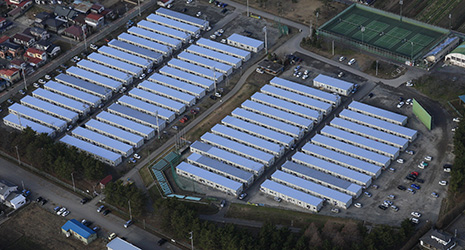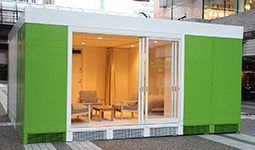Home > Highlighting JAPAN > Highlighting Japan March 2018 > Technologies for Disaster Mitigation
Highlighting JAPAN


Prefabs for Immediate Disaster Relief
A Japanese company is sharing its experience in quick-build temporary houses — as well as prefabricated materials — with disaster-hit communities around the world.
Natural disasters, such as earthquakes and floods, can deprive people of their houses. When houses are destroyed in a disaster and cannot easily be rebuilt, local governments must supply emergency temporary houses on the basis of the Disaster Relief Act.
About 50,000 temporary houses were built when the Great Hanshin-Awaji Earthquake occurred in 1995, about 53,000 were built when the Great East Japan Earthquake occurred in 2011 and about 4,300 were built when two major earthquakes hit Kumamoto Prefecture in 2016.
Daiwa Lease Co., Ltd., which is headquartered in Osaka City, Osaka Prefecture, plays a central role in supplying these large-scale temporary houses. The company engages in a wide range of businesses, including prefabricated construction of offices, factories, stores and public facilities, the lease of temporary buildings, the PFI business (private finance initiatives for public projects), and the development and management of commercial facilities.
Because temporary houses have to be completed in a short period of time in the event of a disaster, materials such as iron frames and external walls are basically produced in factories, and prefabricated buildings for temporary houses are then built at the construction sites.
To respond quickly in the event of a disaster, Daiwa Lease uses materials that are usually used for temporary buildings to construct temporary houses. The company leases numerous prefabricated buildings that the duration of use is short-term and stayed constant, such as temporary offices at construction sites, event facilities and temporary schools. The company demolishes the buildings after they are used, repairs and stores the materials, reuses them for the next lease and in this way puts the building materials into rotational use.
Tetsuya Kita, General Manager of the Prefabricated Structure Division, says, “Our system of storing and reusing materials for constructing prefabricated buildings enables us to build temporary houses in a short period of time. To build temporary houses as soon as possible in the event of a major disaster, we keep stock of materials for 400 houses at all times, draw up a construction manual and conduct simulation drills every year. We believe that we have a social responsibility to build temporary houses.”
The company’s temporary houses are also reused in foreign countries. For example, the materials that had been used for temporary houses when the Great Hanshin-Awaji Earthquake occurred were contributed to Peru through Hyogo Prefecture in 1997, where they were reused to construct an elementary school building. The company’s temporary houses were reused as housing for people affected by a major earthquake in Taiwan in 1999 and as lodging for the United Nations Peacekeeping Forces in the Democratic Republic of Timor-Leste and the Republic of Kosovo in 2000.
Since 2015, Daiwa Lease has accepted participants from twenty-two developing countries in Asia and Africa every year for Improvement and Disaster Prevention of Housing and Living, a study course conducted by the Japan International Cooperation Agency (JICA) in Japan. These study courses provide participants with the opportunity to attend lectures about storing and reusing Japanese prefabricated structures and their materials and visit factories where materials are produced, processed and assembled, and facilities where materials are repaired and stored.
Kita says, “Japan’s strength is that it is able to build a large number of prefabricated structures efficiently in a short amount of time. I do not think that any country apart from Japan has established a system for leases and the reuse of materials.”
In 2013, Daiwa Lease collaborated with Shigeru Ban, an international architect, in developing a system of manufacturing materials for prefabricated structures as housing for low-income people in developing countries in peacetime and providing temporary houses to affected areas, including Japan, in the event of a disaster. In Japan as well, there are limitations to providing emergency temporary houses in the event of a major disaster. This system can contribute not only to coping with these problems but also to improving housing issues and creating jobs in developing countries.
For the main materials of the buildings, FRP Sandwich Panel, which sandwiches a foam urethane insulator with fiber-reinforced plastics (FRP) and does not require any major production facilities, has been adopted. These materials are very light and do not require any special techniques for assembly; a house can be built by four people in six hours.
In 2015, Daiwa Lease cooperated with a local company in the Philippines to produce trial products, and is currently undertaking research and development with the aim of launching the system in Asia.
Kita says, “If countries unify the standards of temporary houses and establish production bases for materials, they will be able to cooperate mutually in producing products in other countries even if there is a shortage of supplies, and in providing temporary houses to a disaster-affected country.”
To support the stability of the lives of disaster-affected people and restoration and reconstruction efforts in the affected areas, Daiwa Lease will make further efforts for improvement, such as through the diversified supply of materials for building prefabricated structures and the utilization of local resources, working together with Ban.
© 2009 Cabinet Office, Government of Japan







